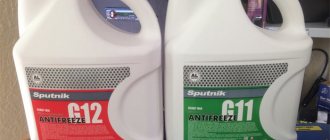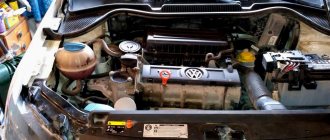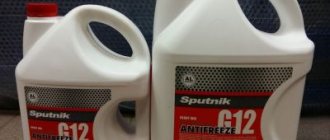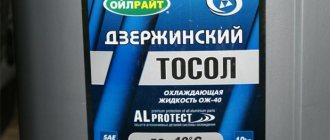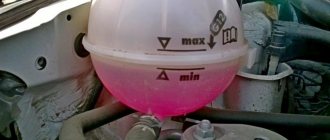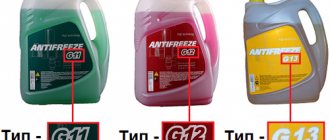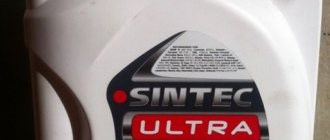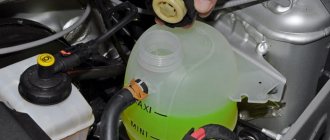Beginning car owners of the domestic automobile industry, learning the basics of car ownership, often ask various questions about servicing and repairing VAZs. One of the most frequently asked questions regarding the cooling system: which is better - Antifreeze or antifreeze for VAZ?
The question is quite interesting and is asked often, especially from owners who purchased a car, but were unable to get a clear answer from the former owner as to what was poured into the cooling system.
And before the winter period, when car preparation is required, this question comes up and makes you think. Let's try to figure it out.
How can I find out what kind of coolant was filled in at the factory?
In the vast majority of cases, it is very easy to find out the brand of antifreeze that was initially poured - just look at the sticker placed on the tank. This sticker always indicates in large letters the liquid with which the system was filled (and which it is recommended to add as needed).
In the vast majority of VAZ 2114 cars, the liquid filled at the factory is either Felix TC-40, produced in Dzerzhinsk, or CoolStream Standart 40, produced in Klimovsk. They can also be distinguished by color.
The first is bright green, the second is either green-yellow or faint green, in both cases there is slight fluorescence. Both of these liquids are antifreeze (belonging to class G11), and they can only be mixed with other liquids from this class.
Antifreeze FELIX
Many people believe that Antifreeze is much worse in quality than antifreeze, so they cannot be mixed. This is incorrect - the reason lies not in the quality or acidity of the medium, but in the very different densities of these two liquids.
If it is not intended to replace the coolant with a liquid of a different category (for example, antifreeze for antifreeze), then you can add it without draining the entire cooling system. Otherwise, this operation will be strictly necessary.
Logbook VAZ 21074 (2006)
I decided to replace the antifreeze that came with the car from the previous owner, they hadn’t changed it for 5 years, if not more, I added other brands several times due to leaks, so there was already a hodgepodge. The liquid itself has long since become cloudy, changed color from blue to blue-green, and a coating has formed at the bottom of the tank.
The previous owner filled it with good antifreeze, Motul roofing felts, Total felts. I decided to change it to a more budget one, but of a higher class from G11 to G12. In the end, I chose Felix red, since there were more reviews about it, and it was more affordable, I ordered it online to save money.
The canister says that the service life is up to 5 years. Let's check)
Also, “through connections” I got the Filin wash, a couple of bubbles.
First, drain the old fluid from the radiator and engine block.
About 8 liters of antifreeze came out (cooling system capacity is 8.6 liters).
We rinse the remainder with water using a high-pressure hose until clear liquid begins to come out of the unit.
Now close the drain holes and fill in the flush. It appears to be a yellowish liquid with almost no odor.
We start the engine and, according to the instructions, let it run for 10-15 minutes until the cooling fan turns on. Let it cool a little and drain.
A yellowish-greenish translucent liquid came out; no flakes or large inclusions were found. Doubts arose that she was able to wash at least something there, although she poured a double dose, but perhaps it all just dissolved or there wasn’t that much dirt. I tried to rinse the tank with concentrate, but nothing came out either, so I left it like that.
We rinse the engine again with running water and let it drain.
While it was draining, I changed a couple of pipes going to the thermostat.
A crack formed on one, and the other was dripping onto the generator (which may have caused the old one to fail) - the rubber became stiff and tightening did not help.
Fill in new antifreeze.
By color: bright scarlet liquid with a fluorescent effect, you should check at night to see if it glows).
We start the engine, turn on the heater, and let it run until all the air is expelled and the fan turns on, close the radiator cap, and top up the tank according to the mark.
Taking into account the expansion tank, it took 9 liters, one liter was left for refilling in the trunk. The stove began to fry almost immediately, so the effect was noticeable. It started dripping a little from the new pipes, but after tightening it stopped. At the same time, I changed the throttle heating pipe - it also became stiff and when pumping air, it cracked and began to leak antifreeze.
Antifreeze 10l - 1050rub
Pipes, clamps - 150 rub.
Subscribe! Good luck on the roads!
Antifreeze or antifreeze - what to choose
Before you find out what antifreeze to pour into the VAZ 2114, you should figure out how, exactly, antifreeze differs from antifreeze? And why can’t they be poured into one system at the same time?
To put it quite simply, dividing coolants into antifreeze and antifreeze is not entirely correct. After all, antifreeze is also one of the varieties of the latter. The point here is that classic antifreeze was developed specifically for VAZ cars and, despite the composition being very close to modern antifreezes, it has a different density.
The presence in the cooling system of two solutions with different specific gravity (antifreeze and antifreeze) can lead to foaming and disruption of coolant circulation.
Antifreeze for VAZ 2114
It is also worth noting that classic antifreeze (its category is marked with the symbols Tl) has a slightly more aggressive chemical environment, which can sometimes even lead to damage to the radiator (of course, with very long-term use of the car). In addition, an important difference between it and antifreeze is that the liquid sold in canisters is a semi-finished product.
In order to pour it into the car’s cooling system, you should dilute it with distilled water in a certain proportion (based on the expected negative ambient temperature).
Currently, the most common categories of coolant are:
- Tl - classic antifreeze, usually blue;
- G11 - green antifreeze (very often also of the “antifreeze” type);
- G12 - red antifreeze (color can vary from yellowish to purple);
- G13 - yellow antifreeze.
Types of coolant for VAZ 2114
Speaking about which antifreeze is best for the VAZ 2114, we can say with confidence - the G11 category. It has a more inert composition from a chemical point of view and is safer for the radiator and cooling system. In addition, it is much more common at present than antifreeze of the classic composition, so there will be no problems with its purchase.
How to fill
You will need the entire previous list of tools, with which you can safely proceed to the second part.
- Tighten the bolt.
- Now fill the radiator with fluid up to the top mark.
- Remove the expansion tank hose and also fill it with liquid. Lift it up and start pouring further, so that it comes out through the other end of the hose. We put the hose back on the radiator. Let's add more.
Lift the reservoir up and add liquid
Done, replacement of antifreeze in the VAZ 2107 has been successfully completed.
What categories of coolant can be mixed
Of course, the best option would be to fill the system only with liquids from one category, but if for some reason this is not possible, then you should use the following compatibility table:
- Antifreeze Tl - only with antifreeze Tl.
- G11 can be mixed with G13, G12+ and G12++.
- G11 must not be added to G12.
- G12 can be mixed with G12+, G++, G13.
- G13 cannot be mixed with G12, but with other types it can.
Being guided solely by the color of the coolant when purchasing/refilling/replacing it is fundamentally wrong. Some manufacturers paint antifreeze and antifreeze in colors different from the generally accepted ones. The color has no effect on the chemical composition and density of the liquid.
How to drain
You will need the following tools:
- Key 13 or head;
Required Tools
- socket wrench 12;
- screwdriver;
- container for draining;
- antifreeze or antifreeze.
Turn off the engine and let it cool, now you can start working.
- Place the machine on a flat surface.
- Open the hood and unscrew the radiator cap.
- Unscrew the cap from the expansion tank.
- Place a container for drainage (volume no less than 5 liters).
- Unscrew the bolt and radiator cap. And now we need to drain everything.
How to drain coolant
Fluid replacement
If you plan to switch the car from antifreeze to antifreeze for any reason, then the old coolant should be drained by unscrewing the plugs in the block and in the radiator. It is worth remembering that this will not help remove the entire volume of coolant (and it is consistently equal to 7.8 liters).
In order to completely clean the entire system, you should fill it with ordinary water and drive the car for about 30 kilometers, after which you should drain everything again and add antifreeze. It goes without saying that this procedure can only be carried out in the warm season, but not in the cold.
Filling with antifreeze
It should be said right away that some motorists perform themselves and advise others to carry out additional procedures for cleaning the system of old coolant - adding vinegar, acetone and other additives to distilled water. It is strictly not recommended to carry out such operations. At best, they will be of no use; at worst, they can cause damage to the cooling system.
How to change coolant
Before replacing the coolant in a VAZ 2107, you need to find an expansion tank, decide on the number of liters to fill and the choice of brand.
The expansion tank is located in the engine compartment, located on the left side of the mudguard, where the bracket is. It is secured with a rubber clamp.
You will need to fill in 10 liters of antifreeze or antifreeze. Which is better is up to you to decide. For example, you can already buy antifreeze ready-made, or you can buy a concentrate and dilute it 50 to 50 with distilled water. Antifreeze is slightly inferior in functionality. You can try using the Drossel brand, which is mainly characterized by quality and reliability.
Before replacement begins, it is necessary to check the level and measuring sensor. If the pointer on the sensor initially shows a high temperature, then this is the main sign of urgent replacement. So, let's start checking the level.
- On the body you will see o, so the level should be 3-4 mm higher.
- Unfasten the rubber strap.
- Remember that you only need to unscrew the reservoir cap with a cold and not running engine. Open this plug and look at the mark.
Which coolant to choose
Every motorist who wants to replace the entire coolant in the car system is interested in what kind of antifreeze to pour into the VAZ 2114? And which one is better not to buy? First of all, it’s worth saying that there are now a very large number of counterfeit coolants on the market, which can be easily recognized by poor-quality packaging and labels. In addition, you should always carefully read the name, which should indicate the category of the liquid.
Popular antifreeze manufacturers
As for brands and manufacturers, preference should be given to the following:
- CoolStream Standard – G11, green;
- CoolStream Premium – G12, orange;
- Lada Concentrate - category G11, produced either by Oil Center (Tolyatti) or Bulgar Lada Plus (Kazan);
- Lada A-40 - similar to Lada Concentrate, but supplied ready-to-use;
- OZH-65 TOSOL-TS - classic antifreeze, produced in the city of Dzerzhinsk;
- OZH-65 TOSOL-TORSA – G11, blue-green color;
- “Antifreeze G-48” – slightly green, G11. Previously produced in Perm, now rare.
Antifreeze for VAZ 2107
In this table you can see the type and color of antifreeze for filling VAZ 2107 produced from 1982 to 2013.
| Year | Engine | Type | Color | Lifespan | Recommended Manufacturers |
| 1982 | for all | TL | blue | 2 years | Prompek, Spidol Super Antifreeze, Antifreeze-40 |
| 1983 | for all | TL | blue | 2 years | Felix, Prompek, Spidol Super Antifreeze, Antifreeze-40 |
| 1984 | for all | TL | blue | 2 years | Lukoil Super A-40, Tosol-40 |
| 1985 | for all | TL | blue | 2 years. | Alaska A-40M, Sapfire, Anticongelante Gonher HD, Antifreeze-40 |
| 1986 | for all | TL | blue | 2 years | Sapfire, Antifreeze-40, Alaska A-40M, AGA-L40 |
| 1987 | for all | TL | blue | 2 years | Felix, Prompek, Spidol Super Antifreeze, Sappfire, Antifreeze-40. |
| 1988 | for all | TL | blue | 2 years | Lukoil Super A-40, AGA-L40, Sappfire, Antifreeze-40 |
| 1989 | for all | TL | blue | 2 years | Alaska A-40M, AGA-L40, Sapfire |
| 1990 | for all | TL | blue | 2 years | Felix, AGA-L40, Speedol Super Antifreez, Sapfire |
| 1991 | for all | TL | blue | 2 years | Lukoil Super A-40, Antifreeze-40, Spidol Super Antifreeze, Sappfire |
| 1992 | for all | TL | blue | 2 years | Antifreeze-40, AGA-L40, Speedol Super Antifriz, Anticongelante Gonher HD |
| 1993 | for all | G11 | green | 3 years | Glysantin G 48, Lukoil Extra, Aral Extra, Mobil Extra, Zerex G, EVOX Extra, Genantin Super |
| 1994 | for all | G11 | green | 3 years | Lukoil Extra, Zerex G, Castrol NF, AWM, GlycoShell, Genantin Super |
| 1995 | for all | G11 | green | 3 years | Glysantin G 48, Havoline AFC, Nalcool NF 48, Zerex G |
| 1996 | for all | G11 | green | 3 years | Mobil Extra, Aral Extra, Nalcool NF 48, Lukoil Extra, Castrol NF, GlycoShell |
| 1997 | for all | G11 | green | 3 years | AWM, EVOX Extra, GlycoShell, Mobil Extra |
| 1998 | for all | G11 | green | 3 years | Havoline AFC, Aral Extra, Mobil Extra, Castrol NF, AWM. |
| 1999 | for all | G11 | green | 3 years | Aral Extra, Genantin Super, G-Energy NF |
| 2000 | for all | G12 | red | 5 years | GlasElf, AWM, MOTUL Ultra, G-Energy, Freecor |
| 2001 | for all | G12 | red | 5 years | Castrol SF, G-Energy, Freecor, Lukoil Ultra, GlasElf. |
| 2002 | for all | G12 | red | 5 years | Freecor, AWM, MOTUL Ultra, Lukoil Ultra |
| 2003 | for all | G12 | red | 5 years | Lukoil Ultra, Motorcraft, Chevron, AWM |
| 2004 | for all | G12 | red | 5 years | MOTUL Ultra, MOTUL Ultra, G-Energy |
| 2005 | for all | G12+ | red | 5 years | Chevron, AWM, G-Energy, Lukoil Ultra, GlasElf |
| 2006 | for all | G12+ | red | 5 years | Chevron, G-Energy, Freecor |
| 2007 | for all | G12+ | red | 5 years | Havoline, MOTUL Ultra, Lukoil Ultra, GlasElf |
| 2008 | for all | G12+ | red | 5 years | Havoline, AWM, G-Energy |
| 2009 | for all | G12+ | red | 5 years | Havoline, MOTUL Ultra, Freecor, AWM |
| 2010 | for all | G12+ | red | 5 years | Havoline, AWM, G-Energy, Freecor |
| 2011 | for all | G12+ | red | 5 years | Frostschutzmittel A, VAG, FEBI, Zerex G |
| 2012 | for all | G12++ | red | from 5 to 7 years | Freecor QR, Freecor DSC, Glysantin G 40, FEBI |
| 2013 | for all | G12++ | red | 5-7 years | FEBI, VAG, Castrol Radicool Si OAT |
The data in the table are similar to those recommended by the VAZ.
